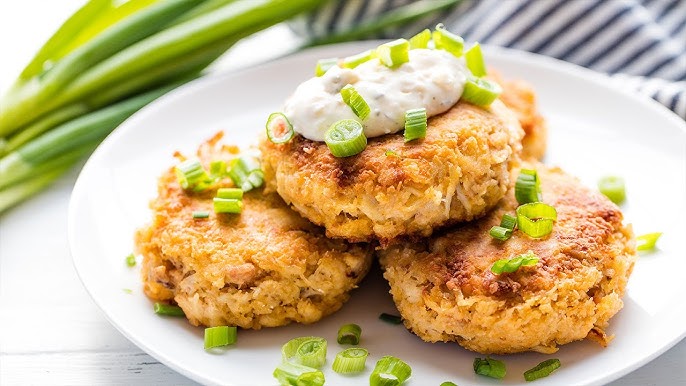Crab Cake Recipe: Crab cakes are a seafood lover’s dream—a savory blend of tender crab meat, seasonings, and just enough binder to hold everything together.
Originating from the U.S., particularly Maryland, crab cakes have become a well-loved dish across coastal regions. While traditionally served with tartar sauce, they can also shine as part of a main meal or an appetizer.
This guide will walk you through the process of creating the perfect crab cakes at home, with tips to ensure your cakes are flavorful, moist, and crisp.
Ingredients for the Perfect Crab Cakes
Let’s dive into the essential ingredients for making mouthwatering crab cakes!
Primary Ingredients
- Crab meat: Fresh is best, but you can use canned or pasteurized crab meat too.
- Eggs: Acts as a binder to hold the mixture together.
- Mayonnaise: Adds moisture and richness.
Seasonings and Herbs
- Old Bay seasoning: This classic blend is key to that authentic flavor.
- Dijon mustard: Brings a slight tanginess.
- Fresh parsley and lemon zest: Brightens up the flavors.
Breadcrumbs and Binders
- Panko or regular breadcrumbs: Provides texture and structure.
- Ritz crackers (optional): Adds buttery flavor if you want a twist.
Tools and Equipment You’ll Need
- Mixing bowl: To combine your ingredients.
- Skillet or frying pan: For pan-frying.
- Spatula: To flip the cakes without breaking them.
- Baking sheet: If you prefer to bake them instead.
Step-by-Step Guide to Making Crab Cakes
Step 1 – Preparing the Crab Meat
Carefully pick through the crab meat to remove any shells. Lump crab meat offers large pieces, while backfin or claw meat is more affordable and slightly sweeter.
Step 2 – Mixing the Ingredients
In a mixing bowl, combine the crab meat, eggs, mayonnaise, mustard, Old Bay seasoning, parsley, lemon zest, and breadcrumbs. Mix gently—overmixing can make the cakes dense.
Step 3 – Shaping the Crab Cakes
Use your hands to form small patties about 3 inches wide. If the mixture feels too wet, add more breadcrumbs. Let the patties chill in the fridge for 30 minutes to help them firm up.
Cooking Options – Pan-fried or Baked?
Pan-frying Crab Cakes
Heat oil in a skillet over medium heat. Cook the cakes for 3-4 minutes per side until golden brown. Avoid overcrowding the pan to get a nice crust.
Baking Crab Cakes in the Oven
For a healthier option, bake the crab cakes at 400°F (200°C) for about 12-15 minutes. Flip halfway to ensure even cooking.
How to Make a Simple Tartar Sauce for Serving
Combine mayonnaise, chopped pickles, capers, lemon juice, and a dash of salt and pepper. This sauce complements the crab cakes perfectly!
Best Sides to Serve with Crab Cakes
- Coleslaw: Adds a refreshing crunch.
- Roasted vegetables: Balances the richness of the crab cakes.
- French fries or sweet potato fries: Always a crowd-pleaser.
Tips to Prevent Crab Cakes from Falling Apart
Use enough binder, but don’t overdo it. Refrigerating the cakes before cooking helps them hold their shape.
Storing and Reheating Crab Cakes
Store leftover crab cakes in an airtight container in the fridge for up to 3 days. Reheat them in the oven at 350°F (175°C) for 10 minutes to keep them crisp.
Common Mistakes to Avoid When Making Crab Cakes
- Overworking the mixture: This can lead to dense, chewy cakes.
- Too much filler: Crab should be the star!
- Incorrect cooking temperature: Keep the heat at medium to prevent burning.
Variations of Crab Cakes from Around the World
- Maryland-style: Simple with minimal filler.
- Asian-inspired: With ginger, soy sauce, and chili.
- Gluten-free: Swap breadcrumbs with almond flour or gluten-free panko.
Nutritional Information of Crab Cakes
Crab is low in fat and high in protein, vitamins, and minerals. A typical crab cake contains around 200 calories, depending on the ingredients and cooking method.
FAQs about Crab Cake Recipe
1. What are crab cakes made of?
Crab cakes typically consist of fresh crab meat, breadcrumbs, mayonnaise, eggs, and seasoning. Some recipes may include mustard, Worcestershire sauce, or fresh herbs to enhance the flavor.
2. What type of crab meat is best for crab cakes?
Lump or jumbo lump crab meat is preferred for its sweet, delicate flavor and texture. However, backfin crab meat can also be used if you want a more economical option.
3. How do you keep crab cakes from falling apart?
To prevent crab cakes from breaking, chill the mixture for 30 minutes before cooking. Ensure the right balance between crab meat and binders like eggs and breadcrumbs.
4. Can I bake crab cakes instead of frying them?
Yes, crab cakes can be baked at 375°F (190°C) for about 20 minutes or until golden brown. Baking offers a healthier alternative to frying with less oil.
5. What sauce pairs well with crab cakes?
Remoulade sauce, tartar sauce, or a squeeze of lemon complements crab cakes perfectly. A light salad on the side also enhances the dish.
6. Can I freeze crab cakes?
Yes, crab cakes can be frozen either raw or cooked. To freeze, wrap them individually in plastic wrap, place them in a freezer-safe bag, and store them for up to 3 months.
7. How do I reheat crab cakes?
For the best texture, reheat crab cakes in an oven at 350°F (175°C) for 10-15 minutes. Avoid microwaving, as it can make them soggy.
8. Are crab cakes gluten-free?
Traditional crab cakes are not gluten-free due to breadcrumbs. However, you can make gluten-free crab cakes by using gluten-free breadcrumbs or crushed rice crackers.
9. What sides go well with crab cakes?
Popular sides include coleslaw, roasted vegetables, potato salad, or a light citrus salad, all of which complement the crab’s flavor.
10. What is the origin of crab cakes?
Crab cakes are believed to have originated in Maryland, USA, where fresh blue crab is abundant. They remain a staple of coastal cuisine today.
Conclusion
Experimenting with the crab cake recipe is a great way to discover new flavors that suit your taste. Don’t be afraid to try different spices, sauces, or even switch up the type of crab used for a unique twist. Whether adding a dash of Old Bay seasoning or experimenting with a spicy aioli, small changes can elevate your dish to the next level.
One essential tip is to always use fresh ingredients. Fresh crabmeat ensures the best flavor and texture, while fresh herbs, lemon, and breadcrumbs enhance the taste. By prioritizing quality ingredients, you’ll enjoy crab cakes that are flavorful, moist, and unforgettable every time you make them.
References
To enhance credibility and provide additional resources for further reading, we have cited trusted sources throughout this Crab Cake Recipe with Post Links. These references offer comprehensive insights into crab cake preparation, variations, and cooking tips. Explore them to validate the information provided and discover even more ways to perfect your recipe:
- Food Network – Expert tips and regional variations of crab cakes.
- Bon Appétit – Innovative crab cake recipes and gourmet approaches.
- AllRecipes – User-submitted recipes with helpful reviews and ratings.
- Serious Eats – Detailed cooking guides for achieving the perfect texture.
- The New York Times Cooking – A mix of classic and modern takes on crab cakes.
Feel free to delve into these resources to enrich your understanding and experiment with new ideas for your next crab cake dish!



